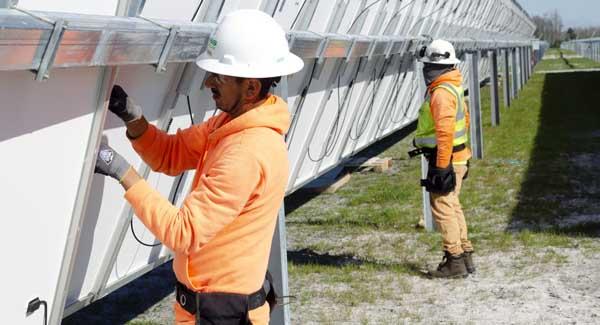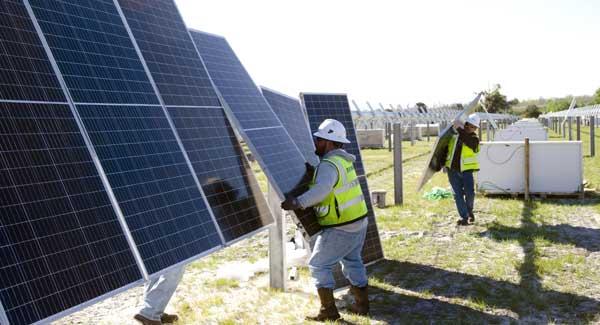Beginning this spring, Beaches Energy will begin supplying solar power to about 10,000 customers as part of the Florida Municipal Solar Project, the largest municipal-backed solar project in the nation.
Solar panels were recently installed as part of the first phase of the project located at the Harmony Solar Energy Center in Osceola County. The solar site is one of five that will be part of the project that will serve 12 municipal utilities, including Beaches Energy.
“We’re thrilled to see the start of nearly 1.5 million solar panels being installed,” said Jacob Williams, general manager and CEO of the Orlando-based wholesale power agency. “When completed, these solar sites will add to our clean power generation and provide affordable energy to our customers.”
Florida Municipal Power Association serves as the project coordinator, and the 12 municipal utilities, who are member-owners of FMPA, will purchase power from the project. The utilities include Alachua, Bartow, Beaches Energy Services, Fort Pierce Utilities Authority, Homestead, Keys Energy Services, Kissimmee Utility Authority, Lake Worth Beach, Ocala, Orlando Utilities Commission, Wauchula and Winter Park.
“There’s actually three sites being built, just like the one they are talking about in Harmony. Each one is about 75 megawatts,” said Beaches Energy Director Allen Putnam. “Our portion of it is about 15 megawatts that will serve about 3,000 homes. Totally each site itself will serve about 15,000 homes.”
Construction began in November 2019, and will include a total of 900,000 solar panels at two sites in Osceola County and at one site in Orange County. The total generating capability will be 223.5 megawatts of zero-emissions energy, which is enough to power 45,000 typical Florida homes.
“Beaches Energy serves 35,000 customers and the equivalent of 30,000 will be served by solar by mid-summer," said Putnam. "It’s a little bit pricier than what we pay for regular generation. This is a little bit higher than that but it’s a clean, non-carbon-emitting source of energy. We can’t provide all of our power with solar but this at least gives us some of our capacity in solar which our customers ask for.
“Our customers generally want solar, they just don’t want to pay more. So, we thought this was the most economical way. It actually costs three to four times less than it does to put [solar panels] on your rooftop, so we thought it would be a good way to put it into our system so our customers can benefit without having to pay a whole lot more. Not all roofs are made for the most optimum set up of solar. This is just a much cheaper option for our customers to benefit from solar power.”
The cost of solar energy from this project is about one-third the cost of electricity from a typical private, rooftop system. The ground-mounted solar panels have a computer-controlled tracking system that moves the panel to track the sun as it travels from east to west, maximizing power output.
The builder, owner and operator of the solar farms is Florida Renewable Partners, whose parent company is the world’s largest generator of renewable energy from wind and the sun. With construction underway, FMPA and its members continue to expand solar power generation. In December, the group announced Phase II, which will add two solar sites that are expected to come online by the end of 2023. According to Putnam, Beaches Energy has already purchased the ability to add an additional 10 megawatts. Construction is slated to begin this fall.
“That represents about 25 to 30 percent of our average daily usage. That’s probably as much as we will go for the near future until we see if prices come down more. I don’t think there’s much room left,” noted Putnam. “I think we’re at the point where you can’t get any more out of solar power unless we discover some new type of material we don’t know about. You can’t provide all the power because the sun doesn’t always shine.”
Upon completion of Phase II of the project in 2023, the utilities will have a total of nearly 375 megawatts of zero-emissions energy, which is enough to power 75,000 typical Florida homes.
Beaches Energy will begin supplying solar power
By
Liza Mitchell, Contributor


